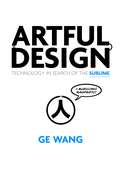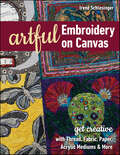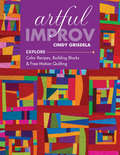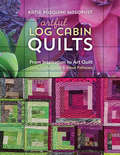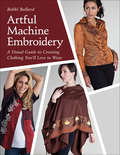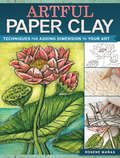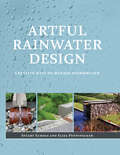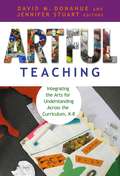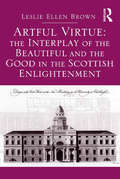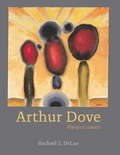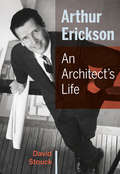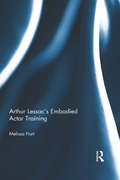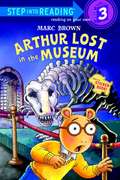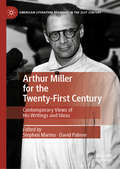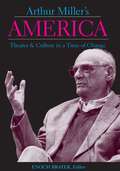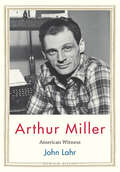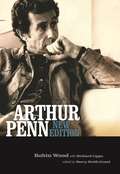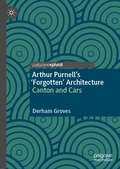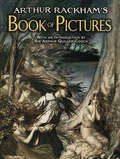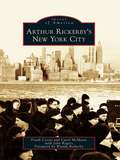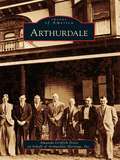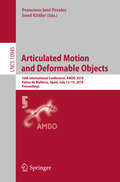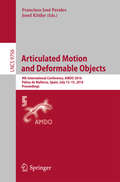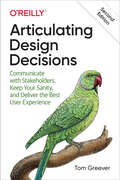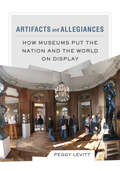- Table View
- List View
Artful Design: Technology in Search of the Sublime, A MusiComic Manifesto
by Ge WangWhat we make, makes us. This is the central tenet of Artful Design, a photorealistic comic book that examines the nature, purpose, and meaning of design. A call to action and a meditation on art, authenticity, and social connection in a world disrupted by technological change, this book articulates a fundamental principle for design: that we should design not just from practical needs but from the values that underlie those needs. Artful Design takes readers on a journey through the aesthetic dimensions of technology. Using music as a universal phenomenon that has evolved alongside technology, this book breaks down concrete case studies in computer-mediated toys, tools, games, and instruments, including the best-selling app Ocarina. Every chapter elaborates a set of general design principles and strategies that illuminate the essential relationship between aesthetics and engineering, art and design. Ge Wang implores us to both embrace and confront technology, not purely as a means to an end, but in its potential to enrich life. Technology is never a neutral agent, but through what we do with it—through what we design with it—it provides a mirror to our human endeavors and values. Artful Design delivers an aesthetic manifesto of technology, accessible yet uncompromising.
Artful Embroidery on Canvas: Get Creative with Thread, Fabric, Paper, Acrylic Mediums & More
by Irene SchlesingerTransform ordinary artist canvas into an embroidered masterpiece! With easy-to-learn stitches, your embroidery needle becomes a paintbrush to stitch creative ideas into life. Get your feet wet with small art pieces and step-by-step techniques for stitching on stretched canvas. Gather supplies to add appliqué, acrylic paint, fibers, beads, and even mirrors to your mixed-media pieces! Get tips on how to finish and display canvas embroidery art, with an extensive project gallery for inspiration. It’s like art quilting for needlework lovers! Embellish unique art pieces with fibers, sequins, beads, paper, paint, and more Amateur embroiderers and experienced needleworkers alike will love seeing their work from an artist’s point of view Get started with three small sample projects
Artful Improv: Explore Color Recipes, Building Blocks & Free-Motion Quilting
by Cindy Grisdela“Do away with patterns and embrace your creative spirit with this vibrant and fun book.” —Quilting Arts With simple design principles, you can create unique improvisational quilts. Without using patterns, learn five easy piecing techniques for your improvisational toolbox (including circles, blocks, and strips), and watch the art unfold before your eyes. Focus on color combos and negative space to discover your personal style—and then add dazzling texture with free-motion quilting.Also included is information on hanging finished art quilts without a sleeve, plus tried and true improv tips to encourage creative play.
Artful Log Cabin Quilts: From Inspiration to Art Quilt: Color, Composition & Visual Pathways
by Katie Pasquini Masopust“Stunning . . . packed with inspiration and practical advice to help quilters of all abilities create unique abstract art quilts from photographs and images.” —Pretty PatchesTake the first steps to becoming an art quilter with popular teacher and bestselling author Katie Pasquini Masopust. Starting with an inspiration image, choose fabrics to create your own artistic log cabin quilts. Learn to navigate visual pathways and composition, applying easy techniques and experimenting with color. Student work is showcased to prove that anyone can create an art quilt! Design and make your masterpiece with freeform log cabin blocks using this versatile method.“As she demonstrates, a simple log cabin block can become a rich and dynamic fiber art statement through inspired use of color, fabric choices and placement.” —Generation Q Magazine“Her method is sure to result in something that is personal, unique and very satisfying.” —Down Under Textiles“This is a fascinating approach to creating original designs with traditional piecing methods.” —Machine Quilting Unlimited
Artful Machine Embroidery: A Visual Guide to Creating Clothing You'll Love to Wear
by Bobbi BullardLearn to bring flare and sophistication to your clothes and accessories with this guide to machine embroidery by an award-winning designer.Bobbi Bullard is known for her unique and elegantly crafted embroidery designs. Now she shares her tips and techniques for turning hand-sewn or store-bought clothing into wearable art that you can really wear. Bobbi shows you how to use basic design principles to get professional-looking results with any home embroidery machine. Artful Machine Embroidery includes a complete supply guide to ensure your work is successful. Whether you’re embellishing hand-sewn or store-bought clothing, you’ll learn how to add sophisticated designer style that is uniquely you.This eBook edition includes a link to 20 downloadable designs for borders, motifs, applique, Richelieu, and lace.
Artful Paper Clay: Techniques for Adding Dimension to Your Art
by Rogene ManasCreate Beautiful Paintings With Dimension Forge a bold creative path by adding hand-sculpted elements to your two-dimensional work. Discover an entirely fresh and fun approach for creating fine art with paper clay, developed by artist and teacher Rogene Mañas. This all-new bas-relief art form combines air-drying clay, paint, collage and texture to build dimensional mixed-media works that pop right off the wall. The book is divided into four parts:Part 1: Working with Clay - Techniques and tips to begin working with clay in bas-relief, starting with the absolute basics. Includes 15 easy practice projects to work on cutting, shaping, sculpting and stamping.Part 2: Clay Work Projects - 5 full step-by-step clay-art project demos. Create your own art using Rogene's methods for composing, sculpting, placing and drying.Part 3: Finishing Techniques - Finish the 5 demonstrations from Part 2 with different painting, collage and mixed-media techniques.Part 4: Get Creative - Includes ideas for framing, practice patterns, creative exercises and additional three-dimensional art projects and gifts.Whether you're a seasoned sculptor or just starting out, Artful Paper Clay will teach you the skills necessary to craft complex and vivacious multi-dimensional masterpieces and paint them for gorgeous effect.
Artful Rainwater Design: Connecting Theory, Practice, And Possibilities
by Stuart Echols Eliza PennypackerStormwater management as art? Absolutely. Rain is a resource that should be valued and celebrated, not merely treated as an urban design problem--and yet, traditional stormwater treatment methods often range from ugly to forgettable. Artful Rainwater Design shows that it's possible to effectively manage runoff while also creating inviting, attractive landscapes. This beautifully illustrated, comprehensive guide explains how to design creative, yet practical, landscapes that treat on-site stormwater management as an opportunity to enhance site design. Artful Rainwater Design has three main parts: first, the book outlines five amenity-focused goals that might be highlighted in a project: education, recreation, safety, public relations, and aesthetic appeal. Next, it focuses on techniques for ecologically sustainable stormwater management that complement the amenity goals. Finally, it features diverse case studies that show how designers around the country are implementing principles of artful rainwater design. Artful Rainwater Design is a must-have resource for landscape architects, urban designers, civil engineers, and architects who won't let stormwater regulations cramp their style, and who understand that for a design to truly be sustainable, people must appreciate and love it. It is a tool for creating landscapes that celebrate rain for the life-giving resource it is--and contribute to more sustainable, healthy, and even fun, built environments.
Artful Teaching: Integrating the Arts for Understanding Across the Curriculum
by David M. Donahue Jennifer StuartThe authors in this volume share exemplary arts-integration practices across the K–8 curriculum. Rather than providing formulas or scripts to be followed, they carefully describe how the arts offer an entry point for gaining insight into why and how students learn. The book includes rich and lively examples of public school teachers integrating visual arts, music, drama, and dance with subject matter, including English, social studies, science, and mathematics. Readers will come away with a deeper understanding of why and how to use the arts every day, in every school, to reach every child. Both a practitioner’s guide and a school reform model, this important book: <P><P> Explains how arts integration across the K–8 curriculum contributes to student learning. Features examples of how integrated arts education functions in classrooms when it is done well. Explores intensive teacher-education and principal-training programs now underway in several higher education institutions. Offers concrete ideas for educators who are looking to strengthen their own skills and improve student opportunities for learning.
Artful Virtue: The Interplay of the Beautiful and the Good in the Scottish Enlightenment
by Leslie Ellen BrownDuring the Scottish Enlightenment the relationship between aesthetics and ethics became deeply ingrained: beauty was the sensible manifestation of virtue; the fine arts represented the actions of a virtuous mind; to deeply understand artful and natural beauty was to identify with moral beauty; and the aesthetic experience was indispensable in making value judgments. This book reveals the history of how the Scots applied the vast landscape of moral philosophy to the specific territories of beauty - in nature, aesthetics and ethics - in the eighteenth century. The author explores a wide variety of sources, from academic lectures and institutional record, to more popular texts such as newspapers and pamphlets, to show how the idea that beauty and art made individuals and society more virtuous was elevated and understood in Scottish society.
Arthur Dove: Always Connect
by Rachael Z. DelueArthur Dove, often credited as America's first abstract painter, created dynamic and evocative images inspired by his surroundings, from the farmland of upstate New York to the North Shore of Long Island. But his interests were not limited to nature. Challenging earlier accounts that view him as simply a landscape painter, Arthur Dove: Always Connect reveals for the first time the artist's intense engagement with language, the nature of social interaction, and scientific and technological advances. Rachael Z. DeLue rejects the traditional assumption that Dove can only be understood in terms of his nature paintings and association with photographer and gallerist Alfred Stieglitz and his circle. Instead, she uncovers deep and complex connections between Dove's work and his world, including avant-garde literature, popular music, meteorology, mathematics, aviation, and World War II. Arthur Dove also offers the first sustained account of Dove's Dadaesque multimedia projects and the first explorations of his animal imagery and the role of humor in his art. Beautifully illustrated with works from all periods of Dove's career, this book presents a new vision of one of America's most innovative and captivating artists--and reimagines how the story of modern art in the United States might be told.
Arthur Erickson
by David StouckArthur Erickson, Canada's pre-eminent philosopher architect, was renowned internationally for his innovative approach to landscape, his genius for spatial composition, and his epic vision of architecture for people. Among his most celebrated large-scale works are three that helped to define Vancouver's urban landscape: Simon Fraser University, on Burnaby Mountain; the Robson Square complex at the heart of the city; and the exquisite Museum of Anthropology at the University of British Columbia. Travel was key to Erickson's creative process; floating high above the clouds on extended airline flights, he made preliminary drawings on vellum with his fine-point black felt-tip pen, designing influential works not only for other parts of Canada-including Toronto's widely admired Roy Thomson Hall--but for sites in the U.S., Britain, and the Middle and Far East. Erickson worked chiefly in concrete, which he called "the marble of our times," and wherever they appear, his buildings move the spirit with their poetic freshness and their mission to inspire. But he was also a controversial figure, more than once attracting the ire of his fellow architects, and his professional achievements were tarnished by the excesses of a complicated personal life that resulted in a series of tawdry bankruptcies. In a fall from grace that recalls a Greek tragedy, Canada's great architect-a handsome, elegant man who lived like a millionaire and counted among his close friends Pierre Trudeau and Elizabeth Taylor-eventually became homeless and penniless.This first full biography of Erickson, who died in 2009 at the age of eighty-four, traces the architect's life from its modest origins to his emergence on the world stage. Author David Stouck, acclaimed for his earlier biographies of Ethel Wilson and Sinclair Ross, demonstrates here once again why his work has been praised as imaginative, incisive and compelling. Grounded in interviews with Erickson and his family, friends and clients, as well as the resources of extensive public archives, TITLE is both an intimate portrait of the man and a stirring account of how Erickson made his buildings work. Beautifully written and superbly researched, it is also a provocative look at the phenomenon of cultural heroes and the nature of what we call "genius."
Arthur Lessac's Embodied Actor Training
by Melissa HurtArthur Lessac’s Embodied Actor Training situates the work of renowned voice and movement trainer Arthur Lessac in the context of contemporary actor training. Supported by the work of Constantin Stanislavsky and Maurice Merleau-Ponty's theories of embodiment, the book explores Lessac's practice in terms of embodied acting, a key subject in contemporary performance. In doing so, the author explains how the actor can come to experience both skill and expression as a subjective whole through active meditation and spatial attunement. As well as feeding this psychophysical approach into a wider discussion of embodiment, the book provides concrete examples of how the practice can be put into effect. Using insights gleaned from interviews conducted with Lessac and his Master Teachers, the author enlightens our own understanding of Lessac’s practices. Three valuable appendices enhance the reader’s experience. These include: a biographical timeline of Lessac’s life and career sample curricula and a lesson plan for teachers at university level explorations for personal discovery Melissa Hurt is a Lessac Certified Trainer and has taught acting and Lessac’s voice, speech, and movement work at colleges across the United States. She has a PhD from the University of Oregon and an MFA from Virginia Commonwealth University.
Arthur Lost in the Museum
by Marc BrownArthur goes with his class on a field trip to the museum, but takes a wrong turn when heading for the bathroom.
Arthur Miller for the Twenty-First Century: Contemporary Views of His Writings and Ideas (American Literature Readings in the 21st Century)
by Stephen Marino David PalmerArthur Miller for the Twenty-First Century: Contemporary Views of His Writings and Ideas brings together both established Miller experts and emerging commentators to investigate the sources of his ongoing resonance with audiences and his place in world theatre. The collection begins by exploring Miller in the context of 20th-century American drama. Chapters discuss Miller and Eugene O’Neill, Tennessee Williams, Edward Albee, David Mamet, and Sam Shepard, as well as thematic relationships between Miller’s ideas and the explosion of significant women and African American dramatists since the 1970s. Other essays focus more directly on interpretations of Miller’s individual works, not only plays but also essays and fiction, including a discussion of Death of a Salesman in China. The volume concludes by considering Miller and current cultural issues: his work for human rights, his depiction of American ideals of masculinity, and his anticipation of contemporary posthumanism.
Arthur Miller's America
by Enoch BraterPerspectives on America's greatest living playwright that explore his longstanding commitment to forging a uniquely American theater Arthur Miller's America collects new writing by leading international critics and scholars that considers the dramatic world of icon, activist, and playwright Arthur Miller's theater as it reflects the changing moral equations of his time. Written on the occasion of Miller's 85th year, the original essays and interviews in Arthur Miller's America treat the breadth of Miller's work, including his early political writings for the campus newspaper at the University of Michigan, his famous work with John Huston, Clark Gable and Marilyn Monroe on The Misfits, and his signature plays like Death of a Salesman and All My Sons.
Arthur Miller: American Witness (Jewish Lives)
by John LahrA great theater critic brings twentieth-century playwright Arthur Miller&’s dramatic story to life with bold and revealing new insights &“New Yorker critic Lahr shines in this searching account of the life of playwright Arthur Miller. . . . It&’s a great introduction to a giant of American letters.&”—Publishers Weekly Distinguished theater critic John Lahr brings unique perspective to the life of Arthur Miller (1915–2005), the playwright who almost single-handedly propelled twentieth-century American theater into a new level of cultural sophistication. Organized around the fault lines of Miller&’s life—his family, the Great Depression, the rise of fascism, Elia Kazan and the House Committee on Un-American Activities, Marilyn Monroe, Vietnam, and the rise and fall of Miller&’s role as a public intellectual—this book demonstrates the synergy between Arthur Miller&’s psychology and his plays. Concentrating largely on Miller&’s most prolific decades of the 1940s, 1950s, and 1960s, Lahr probes Miller&’s early playwriting failures; his work writing radio plays during World War II after being rejected for military service; his only novel, Focus; and his succession of award-winning and canonical plays that include All My Sons, Death of a Salesman, and The Crucible, providing an original interpretation of Miller&’s work and his personality.
Arthur Penn: New Edition
by Barry Keith Grant Robin Wood Richard LippeArthur Penn--director of The Miracle Worker, Bonnie and Clyde, Alice's Restaurant, and Little Big Man--was at the height of his career when Robin Wood's analysis of the American director was originally published in 1969. Although Wood then considered Penn's career only through Little Big Man, Arthur Penn remains the most insightful discussion of the director yet published. In this new edition, editor Barry Keith Grant presents the full text of the original monograph along with additional material, showcasing Wood's groundbreaking and engaging analysis of the director. Of all the directors that Wood profiled, Penn is the only one with whom he developed a personal relationship. In fact, Penn welcomed Wood on the set of Little Big Man (1969), where he interviewed the director during production of the film and again years later when Penn visited Wood at home. Both interviews are included in this expanded edition of Arthur Penn, as are five other pieces written over a period of sixteen years, including the extended discussion of The Chase that was the second chapter of Wood's later important book Hollywood from Vietnam to Reagan. The volume also includes a complete filmography and a foreword by Barry Keith Grant. The fourth classic monograph by Wood to be republished by Wayne State University Press, this volume will be welcomed by film scholars and readers interested in American cinematic and cultural history.
Arthur Purnell’s ‘Forgotten’ Architecture: Canton and Cars
by Derham Groves“Derham Groves has written this illuminating story of an exceptional but hitherto unsung Australian architect whose distinctive designs in China as well as his homeland may still be seen and enjoyed. In this book Groves has for the first time revealed some characteristic strands of Arthur Purnell’s talents, whereby his subject’s remarkable creativity is now clear for us to enjoy.” - Robert Irving, architecture historian and pupil of Arthur PurnellArthur Purnell’s ‘Forgotten’ Architecture: Canton and Cars focuses on two early phases in the career of the much overlooked and underrated Australian architect, Arthur Purnell (1878–1964). In 1903, Purnell teamed up with the American engineer, Charles Paget (1874–1933) in Canton, China. Between 1903 and 1910, Purnell and Paget designed many important and impressive buildings, including the Arnhold, Karberg & Co. building (1907), one of the first reinforced concrete buildings in Southern China, and the South China Cement Factory (1907), which would later become the headquarters of Dr. Sun Yatsen (1866–1925), the first president of the Republic of China. Not many architects can design a cement factory fit for a president’s palace! When Purnell returned to Australia in 1910, he had to start again from scratch. As cars were taking over from horses in a big way, he saw that designing for cars would be the next big thing in architecture. The fledgling Australian car industry was full of colourful, larger-than-life characters like Col. Harley Tarrant (1860–1949), who built his first car in 1897 and Australia’s first petrol-fuelled car in 1901, and Alec Barlow Sr. (1880–1937), the archetypal dodgy car salesman. Purnell wanted in, designing many buildings for both men, including early car factories and car showrooms. In this unique book, Groves asks: why isn’t Arthur Purnell more famous?
Arthur Rackham's Book of Pictures
by Arthur Rackham Sir Arthur Quiller-CouchThis wonderful survey of the famed artist's early work features 44 color plates in addition to several black-and-white vignettes and spot illustrations. Most of the images depict fantastic dwarfs, giants, elves, and fairies as well as naturalistic illustrations far removed from the fairy world. An elegant offering for all Rackham fans, this volume includes many long-unavailable pieces.
Arthur Rickerby's New York City
by Frank Ceresi Wanda Rickerby John Rogerts Carol McmainsArthur Rickerby's illustrious career was spent capturing scores of the nation's significant historical events on film, from the Japanese signing of the Articles of Surrender aboard the USS Missouri in 1945, ending World War II, to famous sports images such as Don Larsen throwing the final pitch of baseball's only World Series perfect game for the New York Yankees in 1956. Today few people know of Arthur Rickerby, the New York born and bred photographer. Arthur Rickerby's New York City not only reintroduces the world-class photojournalist and pays tribute to his outstanding work, but it also features rare and previously unseen New York images that perfectly capture the enduring Rickerby touch.
Arthurdale
by Inc. Arthurdale Heritage Amanda Griffith PenixIn August 1933, Eleanor Roosevelt visited the impoverished coal communities of north central West Virginia. Suffering from the effects of the Great Depression, these coal families looked to the First Lady for help out of the devastating economic times. Her visit spurred the creation of Arthurdale, the nation's first New Deal Homestead Community. Arthurdale quickly became known as "Eleanor's Little Village" because of the First Lady's involvement with the project. She visited the community often to dine, dance, and converse with the homesteaders and to attend high school graduations. In addition to the creation of new housing, Arthurdale featured a community business center, state-of-the-art school buildings, a craft industry, an industrial factory, and home-based agricultural production. Although not a financial triumph for the federal government, the social success of the community is immeasurable.
Articulated Motion and Deformable Objects: 10th International Conference, AMDO 2018, Palma de Mallorca, Spain, July 12-13, 2018, Proceedings (Lecture Notes in Computer Science #10945)
by Josef Kittler Francisco José PeralesThis book constitutes the refereed proceedings of the 10th International Conference on Articulated Motion and Deformable Objects, AMDO 2018, held in Palma de Mallorca, Spain, in July 2018.The 12 papers presented were carefully reviewed and selected from 26 submissions. The papers address the following topics: advanced computer graphics and immersive videogames; human modeling and animation; human motion analysis and tracking; 3D human reconstruction and recognition; multimodal user interaction and applications; ubiquitous and social computing; design tools; input technology; programming user interfaces; 3D medical deformable models and visualization; deep learning methods for computer vision and graphics; and multibiometric.
Articulated Motion and Deformable Objects: 9th International Conference, AMDO 2016, Palma de Mallorca, Spain, July 13-15, 2016, Proceedings (Lecture Notes in Computer Science #9756)
by Josef Kittler Francisco José PeralesThis book constitutes the refereed proceedings of the 9th International Conference on Articulated Motion and Deformable Objects, AMDO 2016, held in Palma de Mallorca, Spain, in July 2016. The 20 papers presented were carefully reviewed and selected from 34 submissions. The conference dealt with the following topics: advanced computer graphics and immersive videogames; human modeling and animation; human motion analysis and tracking; 3D human reconstruction and recognition; multimodal user interaction and applications; ubiquitous and social computing; design tools; input technology; programming user interfaces; 3D medical deformable models and visualization; deep learning methods for computer vision and graphics; multibiometric.
Articulating Design Decisions: Communicate With Stakeholders, Keep Your Sanity, And Deliver The Best User Experience
by Tom GreeverTalking to people about your designs might seem like a basic skill, but it can be difficult to do well. In many cases, how you communicate with stakeholders, clients, and other nondesigners may be more important than the designs themselves. Because if you canâ??t get their support, your work will never see the light of dayâ??no matter how good it is.This practical guide focuses on principles, tactics, and actionable methods for presenting your designs. Whether you design apps, websites, or products, youâ??ll learn how to get support from people who have influence over the project with the goal of creating the best user experience.Walk through the process of preparing and presenting your designsUnderstand stakeholder perspectives and learn how to empathize with themCultivate both implicit and explicit listening skillsLearn tactics and strategies for expressing the most effective response to feedbackCreate the right documentation for your decisions to avoid repeated conversationsLearn why following through is just as important as the meeting itself
Artifacts and Allegiances: How Museums Put the Nation and the World on Display
by Peggy LevittWhat can we learn about nationalism by looking at a country’s cultural institutions? How do the history and culture of particular cities help explain how museums represent diversity? Artifacts and Allegiances takes us around the world to tell the compelling story of how museums today are making sense of immigration and globalization. Based on firsthand conversations with museum directors, curators, and policymakers; descriptions of current and future exhibitions; and inside stories about the famous paintings and iconic objects that define collections across the globe, this work provides a close-up view of how different kinds of institutions balance nationalism and cosmopolitanism. By comparing museums in Europe, the United States, Asia, and the Middle East, Peggy Levitt offers a fresh perspective on the role of the museum in shaping citizens. Taken together, these accounts tell the fascinating story of a sea change underway in the museum world at large.
